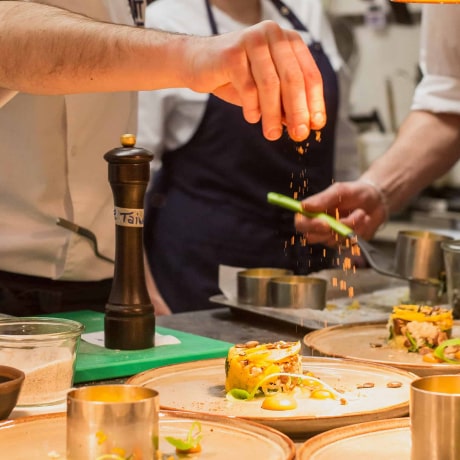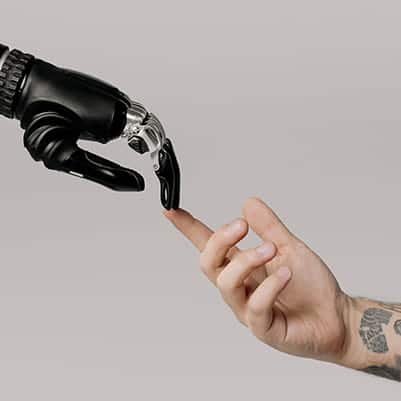The food and beverage industry is an ever-changing business, with new trends popping up every year. It shouldn’t be surprising as our relationship with food often reveals our lifestyle and even our values.
As we will see in the following paragraphs, a growing concern for the environment and society is radically changing what we can buy at supermarkets or eat out at restaurants. New brands providing vegetarian and vegan alternatives are filling the shelves of markets all around the globe. Chefs are no longer seen as despots yelling in hectic kitchens but are increasingly turning into activists, advocating for a sustainable way of living and eating.
Furthermore, the pandemic has accelerated the rise of certain trends. Ghost kitchens and the massive deployment of AI in the food and beverage industry are the proof. The former has often been a life-saving opportunity for restaurant owners during these extraordinary times. The latter is helping brands to deliver a better service to consumers, including complying with the highest hygiene standards.
5 Trends in the food and beverage industry for 2022
-
The rise of ghost kitchens
Ghost or dark kitchens are a phenomenon on the rise, propelled by the pandemic. They tended to be in cosmopolitan and dense cities, but are now mushrooming in urban centers everywhere. According to Euromonitor, ghost kitchens could create a $1 trillion global market by 2030. The idea behind it is pretty simple. Instead of worrying about front-of-house costs, dark kitchens focus on one thing only: preparing food for delivery.
What makes them particularly appealing to new entrepreneurs is the reduced costs, which presents a unique opportunity to enter the food and beverage industry. Owners have to worry less about renting costs. Instead, they can focus on marketing and technology, two much-needed aspects when starting a business.
Restaurant owners are not the only ones interested in ghost kitchens. Third-party delivery platforms like Deliveroo UK are also tapping into this booming market. The online food delivery company has set up ‘Editions kitchen’ in which their partners can prepare food in a fully equipped kitchen while Deliveroo takes care of every other detail. In this way, the delivery platform can increase its profits and offer a unique product to its clients. Apart from a fee for its service, the price to pay to cook at Editions Kitchens is exclusivity, meaning that Deliveroo’s partners cannot sell their products through other online platforms within that area.
-
Plant-based food
The demand for vegetarian and vegan food has soared in the last decade. The market value of meat substitutes worldwide is expected to reach 35.5 billion in 2027, from 11.1 billion U.S. dollars registered in 2019. It is in this growing niche that a new generation of brands is entering the food and beverage industry.
Beyond Meat, Moku Foods, or Tofurky are just some of the new brands appealing to consumers looking for plant-based food in their favorite supermarkets. One company, in particular, has been very successful. Heura, the Barcelona-based startup aimed at changing the food industry by providing vegan alternatives, has been nominated for best startup in Spain by the 2021 LinkedIn Top Startups list and has raised 16 million euros in its latest round of funding.
The booming demand for plant-based alternatives is particularly high in new generations, increasingly concerned about their impact on the environment and society as a whole. This change in consumer behavior appeared so stark in Universities in Germany that the 34 canteens and cafes serving Berlin’s student population have started serving a menu that is 68% vegan, 28% vegetarian and only 4% fish or meat-based.
-
Responsible Restaurants
A revolution is happening, and it’s starting from fine dining restaurants. The leaders are a new generation of chefs, worried about the role the food and beverage industry should play in creating a better world. The most famous name is Rene Redzepi that, with his Noma restaurant, has placed the New Nordic movement on the world culinary scene. The movement follows principles like sustainability, locality and respect for the nature. But its major achievement is that the movement has translated this concept from fine-dining restaurants like Noma itself -which has been nominated as the best restaurant in the world– to supermarkets and classrooms.
As highlighted by the Guardian: “Pretty much anywhere in Denmark, you can walk into a supermarket and find ready meals – made with traceable organic produce by co-operative kitchens in Copenhagen – that bear the name of Claus Meyer, Noma’s co-founder.” In addition, Redzepi has founded an NGO called MAD – “food” in Danish-. Through an academy, a symposium, free online resources and public talks, MAD aims at exporting the vision and principles of the new Nordic movement everywhere in the world by creating a new generation of changemakers in the food and hospitality industry.
On the same line, there is another world-known chef: Massimo Bottura, owner of the three Michelin star Osteria Francescana. A few years ago, Bottura envisioned a world without food waste. From that dream, Food for Souls was born. Among the different initiatives they implement, the most notable is the Refettorios, community hubs where people in situations of social and economic vulnerability are served free meals cooked with surplus ingredients that would have otherwise been thrown away. Together with its partners all around the world, Food for Souls has managed to save more than 500 tons of food and serve more than 785 thousand meals.
-
Zero-waste and zero-plastic
The new mantra in the food and beverage industry is zero-waste, and Massimo Bottura is not the only one embracing it. A virtuous circle involving suppliers, the hospitality industry and consumers is shaping the food and beverage industry of tomorrow.
The demand for zero-waste and zero-plastic is creating a powerful industry in which companies like Pakito Angola can thrive. The Angola-based company helps businesses in the tourism and hospitality industry reduce their use of plastic. As Yara Lopes told BEBS in an interview: “When I started Pakito Angola, I was furious by the amount of plastic waste that was growing on the coastline. It was extremely endangering to the environment and our food source. I wanted to do something about it, in a way that could be impactful today and for the future.”
If some restaurants use eco-friendly packaging, others have taken a step further by adopting a holistic zero-waste and zero-plastic approach. At the restaurant and wine bar Rhodora, in Brooklyn, they have banned the use of single-use plastics. Additionally, the restaurant uses only products that can be recycled, upcycled, or composted.
The zero-waste cycle doesn’t end with restaurants. Over the last few years, there has been a surge in app dedicated to fighting food wasting. It’s the case of the app ‘Too Good To Go’. Founded in 2015 in Copenhagen, this pioneering company has turned food surplus into profits. Restaurants, hotels, supermarkets, and bakeries can sell on the app food that otherwise would be wasted. In turn, users can buy the leftovers for a cheaper price. Some people might ask if this important social mission is also profitable for the company. The answer is a loud YES! In 2019, Too Good To Go reached almost 38,000 partners and more than 18 million users.
-
AI in the food and beverage industry
AI is dramatically changing every industry, including the food and beverage sector. It helps companies produce, market, and deliver their products more safely and efficiently. Additionally, it helps businesses reduce their power and water consumption. This, in turn, can reduce the business expenses of a company considerably.
For example, Domino’s Pizza started its partnership with Dragontail System and used AI to scan each pizza to ensure the highest quality and hygiene standards for its clients. It has been especially important since the beginning of the COVID-19 pandemic when hygiene has become essential for consumers.
McDonald’s has used AI for a different scope. The company has decided to make a tremendous transformation and become the Amazon of fast-food chains. The famous digital boards displayed at the drive-thus are now programmed to be more intelligent than ever. The boards market the food by taking into account factors like the weather and will promote the menu items accordingly. So, during a cold day in December, the board might promote a hot chocolate rather than a soda.
Heading towards the future of the food and beverage industry
The only way to thrive in the food and beverage industry is to listen carefully to what consumers want. Sustainability, technology and delivery will shape the future of the food and beverage industry for years to come.
New brands are entering markets once considered niche while companies are finding new ways to reinvent themselves. As new opportunities open up, one is left to wonder where the limit is for this thriving industry.




